- Since 2001, Dairakudakan has been presenting a series of studio performances of works done completely by your younger members called the “Kochuten” series. What are your thoughts about nurturing young artists?
- I don’t think too much about it (laughs). But, while I am doing the group’s choreography, I know these younger members must get ideas of their own and those ideas must accumulate within them. So, I say to them, why don’t you try doing a piece? Then I find out that they aren’t just reading manga all the time like I thought they were. What they do may be different from my work, but that will often make it fresh and interesting to me. But, don’t forget that the people who are doing works for the Kochuten series are members who have already been performing with us for five or ten years.
- In what ways is the choreography different from yours?
- Although there are some elements of our stage style that are maintained, I leave the contents of the works completely up to them. Each person that does one of these stages is in charge of everything from the choreography to the stage art, lighting and music. To carry out that kind of creative task is a real test of one’s sense as an artist. And they know that it doesn’t make me happy when they do something that is just a repetition of my style (laughs), so I’m sure they feel a lot of pressure.
It is very revealing for me to see the kinds of things they are thinking about as they come out in these works. Having the works as a subject of focus also makes it possible for me to have meaningful discussions with these young people in their 20s and 30s [despite the age gap]. My choreography imposes certain demands on them, but they are choreographing their own works with a joyous sense and I wonder how that is being distilled within them. So it is very int eresting for me to find answers in their works.
I make a point not to watch while they are in the practice stage of their works in order to make certain that they will work the pieces up by themselves. Then when it comes to the point about one week before the performance I will point out a few things that should be changed. But I can’t just impose my own sensibilities and say “This is interesting” or “This part is boring” or “Take this part out!” We have to work these things out with a dilemma. - But, if they stray too far from your established style it won’t be Dairakudakan anymore. So where does the borderline lie in that sense?
- That’s a difficult question (laughs). You could say that I have my own range of tolerance, and because there is a lot of randomness or haphazardness to what I do, it doesn’t really surprise me. I could talk about the meaning of “haphazard” if you’d like.
- Is “haphazard” something that can be explained?
- It can, because haphazardness is my basic methodology. For example, tossing a matchstick one day and having it happen to land standing up on its end and being able to enjoy that in terms of possibility percentage. That is my haphazard. Haphazardness is something that we come to see based on the degree to which our minds and bodies (although this is an expression that takes on a different meaning) can grasp it. You can come to see it so often that you have to say “You’ve got to be joking!” (laughs). But even if you are joking, it is still amazing. And when you come to see these things, it can be fascinating.
- If Dairakudakan has something that you could call its own style or literary style or method that you all share, and then Kazuo Ohno and Sankaijuku have their own style, then what is butoh?
- You come to the point where you realize that “butoh is not to be found within butoh.” Although it contains a degree of uncertainty, I have my own style that is different from Sankaijuku and different from Akira Kasai. Although we may have some things in common with Sankaijuku, the individual aspects are different, and in fact “style” in this sense is only something that gets in the way, and we all want to reach the point where we can transcend style. But every time we take a step out in a new direction it is only to return by some roundabout route. So we are always standing at a crossroads, so to speak. Still, it is not a matter of trying to escape from that situation, but rather to encompass the whole and move forward while growing and expanding in an esoteric sort of way. I think that in butoh there is that kind of question of commanding time and place, which in the end means how to be in command of yourself. Still, I would not say that that constitutes a definition of butoh. So it is a difficult question.
- Still, people always try to see something definitive in butoh.
- That involves the capacity for restoration, the ability to reenact, doesn’t it. There is some element of self-conceit involved here, be it in words or in body movement, the same sensibilities are in command. So what is it? If you ask that, I don’t have an answer (laughs).
If you talk about the spirit and power in words or the strength of sources of origin it begins to sound like the realm of ethnology. Well, I think that aspect is involved to some degree, but I also think that you can see a level where the way you hold yourself or the stance you take can do away with all those questions. I think that that kind of presence is also a viable element. - Is that something that holds true not only in Japan but in New York and Seoul as well?
- Yes. You can say that. When you look at the works coming out of other countries or read foreign literature, you understand it, don’t you? You may miss some of the details or nuance, but you know if the person is surprised and you feel the sadness when they cry; we all understand the emotions and passions. Of course this is all based on the premise that people have feelings, although sometimes we see people who don’t seem to (laughs).
- Can we assume that it is these emotions and passions that lie at the core Akaji Maro the artist?
- That is true to a large degree. For example, I think the expression on a person’s face in a jolting moment of surprise is the same any place in the world. And then, the questions of what you think about that sadness, what you think about that tragedy will come back to you.
Well, I can become quite nihilistic, but there may be people who will want to say “Let’s cry together” or “Let’s march together for world peace.”
This is an area where the question of the dancer’s stance arises again, and the response may come back, “Hey, I’m not trying to save the world!” (laughs).
If you wanted to describe our stance and make it sound good, you might say that we are a kind of living sacrifice. The people of butoh are not concerned with questions of art but with showing the existence of the sacrificial body. And it is my personal habit that we go in the direction of not saying anything about that. - I see. So, if there are these emotions and passions the body has to be able to connect to them well. Is the Noguchi Gymnastics Method a way of learning to make that connection?
- The Noguchi Gymnastics Method sees the body as a type of fluid entity and a primal life form is a methodology to some extent, and at our Dairakudakan retreats we start out by explaining what the Noguchi Gymnastics Method is and having the people do them. But I feel that as a method it is not sufficient by itself. The Noguchi method is a kind of idealistic theory of the body, but there remains a question of how you toss foreign elements into it.
For example, we breathe in exhaust gas or cigarette smoke, so we are naturally taking in these terrible substances. We can’t escape from the fact that we are taking in a lot of different things like that.
When we are talking like this, you can get the feeling that we might come up with some vague overall image of what butoh is. But, from the beginning there has never been much of a definition of what butoh is. For example you bring in something foreign and as you are adding some of its rites and rituals you suddenly come up with a mix that looks like a new form. And then you sometimes get the feeling that you want to incorporate that new mix in your own form. Since we are working with our bodies, I think that kind of desire, or greed, comes into it. - In terms of these kinds of feelings or ideas, do you think the butoh of today has changed much compared to when it was starting out in the 1950s and 60s?
- When you are working with the body there will always be some degree of overlap between the past and the present.
- Does that mean that, shall we say within the limits of the body, there is something continuous that is not influenced by the times?
- That’s right. If you are talking about something that is built on a certain type of consciousness, I think you can define something as butoh. Still, the young dancers today may say that limits of the body don’t affect them, because they feel strong and full of life. There is that side too (laughs).
- Why did it happen that dancers went out and discovered this kind of [butoh] body in the 50s and 60s?
- I think it was something that had to come out. Before that there were probably many of the different element existing unconsciously but suddenly there came a time when the situation cause it to be forgotten and people said, “Something is wrong.” That happened to be the 60s. I don’t know if we really want to talk about that, though (laughs).
- It would be too much of a simplification to use the cliché expression “Japan’s high economic growth rate period” (laughs).
- That, I believe, is one of the elements. Everyone had been working so hard after the War, and I think there was some fatigue built up. Stopping to catch their breath, some people finally said “No” or “Stop and look back over your shoulder.” Until then it you would be considered a traitor to the country if you looked back (laughs). With regard to this, however, I think Hijikata and Ohno felt it more intensely than we did. I think they had a strong conviction that they would not become part of the system, that they wouldn’t belong to any group or trust anything that was part of the establishment.
Ohno was more conscious and logical in his approach, I think, while Hijikata was more unconscious, saying, “I can’t be part of your system” and feeling the strongest sense of not belonging. He had a kind of womanly type “I don’t like what I don’t like” side to him, because he would often say, “This is very strong.” When a woman says “I don’t like it because I don’t like it” no amount of explanation is going to change her mind. There is simply no room to get a foot in the door (laughs). - It seems to me that not only Hijikata and Ohno but also Amagatsu and yourself are all very skillful in your use of words. And in fact you all use a lot of words to create images when you are working on the choreography of a butoh work. I would like to ask you about this aspect.
- Basically the words we means to an end like a Zen koan that is intended to take the student beyond the level of words. The body is like a mold that is incapable of motion by itself. But you can move the body by making it respond to words, even though the words are merely a means to that end, and even if they are untrue words. In my case, I will use any words as long as they get the body to move. But that doesn’t mean that the final movement is an embodiment of the words. The meaning lies somewhere else.
The body drinks in the words and they completely dissolve there, leaving only the state of the body, with its movements, and that state, or whatever you wish to call it, is all that exists. Even if you are just standing empty-minded, that is enough. - Is this kind of word use being passed on to the young generation of dancers?
- No. They aren’t that smart yet (laughs). The words don’t become a means to an end because they take them literally. When I say things like “softly,” “hard” or “that repetition” they ask me “Do you mean like this?” or “Do you mean floppily?” or “Am I wrong?” or “Are you explaining it to me?” or “Is it not an explanation?” So, sometimes the words end up sending the body off in the wrong direction.
- So, the words that you and the other butoh artists use are not instructions, are they.
- They are means to an end, but many of the young people still trust in words…. Say “Go!” and they actually get up and leave!
- Maybe it’s because they don’t read novels (laughs). Anyway, when we put together the things we have been talking about, it seems to be a fact that there is something unchanging and universal about the body but there can be considerable gaps in the way people understand words. Considering this, do you have any particular ideas about the younger generation?
- Well, not really (laughs). As long as things are interesting in the context of dance, then it is OK. If they can get to that point without my assistance and acquire the skills to make it on their own, that is good enough for me.
In our work there is something we call the body’s Okippuri (the quality of its stand). It describes the meaning in just standing on a wood floor without doing anything. Since you are not doing anything but standing it is like having something you might call a “taidama”—a variation on the word kotodama (the spirit or magical power in words) where the character for body is substituted for the character for word—is emitting a magical power and even though you are standing still the wavelength of the aura change. In other words, it is a kind of “diversity of the body” that makes the viewer sense a number of directional possibilities. And the first impression people will have is, “What is going on?” or “I’ve never seen anything like this before.” - So, how do you bring people (dancers) from the Noguchi Gymnastics stage to the point where they are making audiences say, “I’ve never seen anything like this before”?
- The Noguchi Gymnastics Method is a sort of concept of the physical body, and the first time I experienced it, I must say it was a shock for me. It was an encounter with a completely new vector running in the opposite direction from my concepts about the body until then. It showed me a completely new image of gymnastics as something flexible and formless rather than a set of strict movements and forms, and that the body was also something flexible and formless.
But, simply being flexible and undirected in movement is nothing in itself. You next ask the question arises What if this bag, this receptacle that is the body is something stiff? What if that receptacle is as hard as a rice bowl and the contents are sloshing around inside it? Or, What if it freezes? So, you move the body while posing these questions. - Earlier you said that words are a means to an end, but does that mean that you can’t dance or you can’t develop the body without imagination expressed words?
- That’s right, you can’t. Even for an action like lowering the body’s center of gravity, I give a variety of examples. In disciplines like kendo (Japanese sword training) and judo, you can’t move on the offensive or defend well if the lower body stance is not set properly. I use examples like the stances of these martial arts.
And then I go beyond those images. We are not martial arts practitioners and we are not trying to beat our opponent (laughs). Then comes the example of the way yakuza gangsters fight. If it is a matter of defined movements, you can tell which person is stronger, but if they come out in a sudden wild act of violence, you won’t know. Like, if they come out with some wild dance they might beat you (laughs).
But even these kinds of words are means to an end. But even so, words are things that are disappearing from our bodies all the time. In order to get the same kind of action, you can use different words, right? There is an endless number of examples. - Does that mean that after changing the way the dancer thinks about the body to some degree you then put them through a lesson actually using a variety of verbal expressions?
- A judgment has to be made about whether words and images alone are enough. This is beginning to sound like a discussion of the master swordsman Miyamoto Musashi or the Tsukahara Bokuden (laughs). Like, even when the master swordsman is relaxing he is never vulnerable. It is that kind of form. What I often says is, “Having a strong presence is one form of technique.” It is not enough just to be there. Even when the body is limp and seemingly formless, there still has to be meaning. I believe there is a method of technique to get to that point.
- In a butoh work there has to be a certain flow of time. How is that decided?
- If it is interesting, you keep doing it. But, the question is how you decide what is interesting and what is not, and when you are actually doing this in a work, one scene usually lasts from 10 to 15 minutes.
Today the speed of the audience is often faster than that of the performers, so they catch what is going on right away. But, of course, this is not an interactive game we are playing with the audience, so whether or not we should be thinking about taking measures to deal with this situation is another question.
However, in order to sustain a flow of time, I think that there are efforts to be made. I think in terms of “ma” (an interval of time, or a pause). It doesn’t necessarily mean being completely still, but I think in terms of creating a still image or creating intervals of pause. In musical terms you could say that I am fond of syncopation. I like that kind of shock, that Western type of ma that is the unexpected pause before the next beat. But then there are times when you think the pause is coming but a beat comes instead. There are times when that kind of discontinuous continuity can be the point to sustaining a time flow. In a pianissimo piece there may be sudden strong pings or pongs. Often you can move an audience more by going from near zero to one than by going from 100 to 101. - What are your thoughts about music?
- That’s a sensitive question. It may come down to a matter of “It is enough to have good sound” but sounds that are highly emotive tend to resemble specific emotions. That’s why I don’t use traditional Japanese music. In an outdoor performance it is not interesting if you use music, but in a theater if there is no sound at all, even I start to feel uneasy. I don’t think you can reach the realm where “even silence is a sound.”
Akaji Maro
Akaji Maro’s representative butoh work Kaiin no Uma performance in South Korea
He talks about butoh today
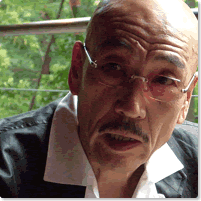
Akaji Maro
Born in Nara Prefecture in 1943. After a period of activity in the theater company “Budo no Kai,” he established the underground theater group “Jokyo Gekijo” with Juro Kara in 1964 and was active as a demonish actor while studying under the butoh pioneer Tatsumi Hijikata. In 1972 Maro established Dairakudakan in pursuit of a new type of fusion between theater and butoh. Since then he has established a style of works that take a positive view of manifestations of the body and emotions that step outside the norms of society as being part of human nature and revives them on stage as specters. These works are staged with spectacle and humor to counterbalance their inherent melancholy in a style that Maro calls Temputenshiki. He has also continued activities as an actor, staring in numerous movies. Since his overseas debut at the American Dance Festival in 1982, Maro has continued to give numerous overseas performances.
Dairakudakan:
http://www.dairakudakan.com/
Over four decades have passed since Tatsumi Hijikata launched a new genre of Japanese expressionist dance (later to be named Ankoku Butoh, or Dance of Darkness) with the work Kinjiki in 1959. This unique Japanese dance form characterized by the whitewashed bodies, open-legged stance, shaved heads and fragmented motion came to be known in the international performing arts world by the Japanese name butoh. But, with the disbanding of many of the early companies and the drift of young dancers toward the new expressive possibilities of contemporary dance, the butoh world has undergone changes.
Still, through all these changes, Akaji Maro’s Dairakudakan continues to perform at the forefront on the dance scene with close to 40 members over 30 years after the company’s founding. And, since 2001 the company has been presenting a series of productions in which individual younger members do everything from the choreography to the direction and decision-making concerning the stage art and music. Within this program we sense the emergence of a new age for the art of butoh.
We spoke to Akaji Maro about butoh on the eve of the first major performance in South Korea of one of his representative works, Kaiin no Uma, at the large-scale dance festival “Korea-Japan Friendship in Dance 2005” to be held in Seoul from June 25 to July 14.
(Interviewer: Jun-ichi Konuma)
Kochuten
Launched in May of 2001, the Kochuten series presents works in which all the decisions involved in the choreography, direction and staging are made by a single butoh artist of the company, with the one requirement that each work contain a solo part performed by the choreographer him/herself. As of June 2005, some 20 works have been presented by Dairakudakan artists including Jun Wakabayashi Takuya Muramatsu, Kumotaro Mukai, Masatora Ishikawa, Ikkou Tamura, Reiko Yaegashi, Eiko Kanesawa, Yuko Kobayashi and Atsuko Imai. Among these, six works have been performed overseas to high acclaim.
Noguchi Gymnastics Method (Noguchi Taisoh)
The Noguchi Gymnastics Method is a set of exercises developed by Michizo Noguchi in the 1960s in search of a system of physical improvement and revitalization. Based on a unique concept of the human body as a mass of fluids inside living bag of skin within which the bone structure and organs are suspended, the Noguchi gymnastics have long been considered a peripheral method by the rest of the gymnastics world but have nonetheless had a major influence in the theater, art and music worlds around the globe.
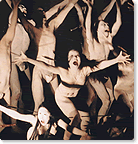
Kaiin no Uma;The Sea-Dappled Horse
Photo: Hiroto Yamazaki
This work premiered in 1982. It is composed of highlight scenes from the monthly series of performances titled Juni no Hikari presented in 1980 at the Toyotamagaran studio (closed 1985). Staged as a spectacle work in which Maro encounters a specter while wandering in search of a phantom horse, this is one of Dairakudakan’s representative works offering a tour de force of the company’s unique art.
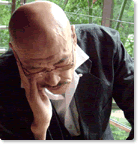

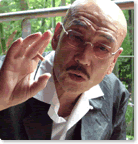

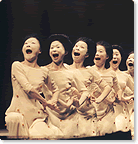
Related Tags

